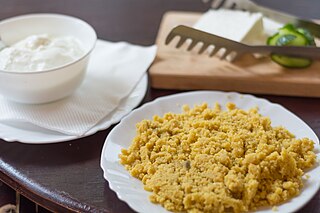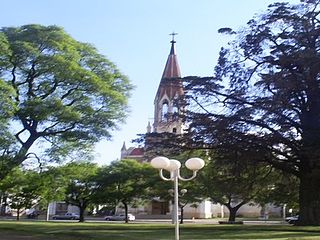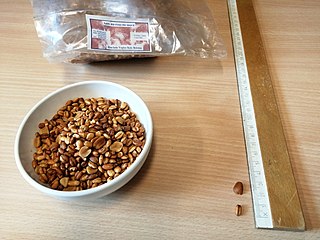
Honey is a sweet and viscous substance made by several species of bees, the best-known of which are honey bees. Honey is made and stored to nourish bee colonies. Bees produce honey by gathering and then refining the sugary secretions of plants or the secretions of other insects, like the honeydew of aphids. This refinement takes place both within individual bees, through regurgitation and enzymatic activity, and during storage in the hive, through water evaporation that concentrates the honey's sugars until it is thick and viscous.

The common sunflower is a species of large annual forb of the daisy family Asteraceae. The common sunflower is harvested for its edible oily seeds, which are often eaten as a snack food. They are also used in the production of cooking oil, as food for livestock, as bird food, and as a plantings in domestic gardens for aesthetics. Wild plants are known for their multiple flower heads, whereas the domestic sunflower often possesses a single large flower head atop an unbranched stem.

Bruce Arthur Johnston is an American singer, musician, and songwriter who is a member of the Beach Boys. He also collaborated on many records with Terry Melcher and composed the 1975 Barry Manilow hit, "I Write the Songs".

Planters Nut & Chocolate Company is an American snack food company now owned by Hormel Foods. Planters is best known for its processed nuts and for the Mr. Peanut icon that symbolizes them. Mr. Peanut was created by grade schooler Antonio Gentile for a 1916 contest to design the company's brand icon. The design was modified by a commercial artist and has continued to change over the years.

Emerald is a rural town and locality in the Central Highlands Region, Queensland, Australia. The town is the headquarters for the Central Highlands Regional Council.

Helianthus is a genus comprising around 70 species of annual and perennial flowering plants in the daisy family Asteraceae commonly known as sunflowers. Except for three South American species, the species of Helianthus are native to North America and Central America. The best-known species is the common sunflower. This and other species, notably Jerusalem artichoke, are cultivated in temperate regions and some tropical regions, as food crops for humans, cattle, and poultry, and as ornamental plants. The species H. annuus typically grows during the summer and into early fall, with the peak growth season being mid-summer.

Kačamak is a kind of maize porridge made in parts of Western Asia and Southeastern Europe. Its name is derived from the Turkish word kaçamak, meaning escapade. It is also known as bakrdan (бакрдан) in North Macedonia.

"Cool, Cool Water" is a song by the American rock band the Beach Boys from their 1970 album Sunflower. It was written by Brian Wilson and Mike Love and later issued as an A-sided single in March 1971.
David Sunflower Seeds, also known as DAVID Seeds, is a brand of roasted and salted sunflower seeds produced by ConAgra Foods in the United States.

"Honey Love" is a song by American R&B singer R. Kelly and his group Public Announcement from Kelly's debut studio album Born into the 90's (1992). It was released as the album's second single on Jive Records in April 1992.

Lincoln is a city in the province of Buenos Aires in Argentina. It is the capital of the district of Lincoln.

Tornquist Partido is a partido in the southwest of Buenos Aires Province in Argentina and is named after Ernesto Tornquist, founder of Tornquist, the partido's main city.

Pinocembrin is a flavanone, a type of flavonoid. It is an antioxidant found in damiana, honey, fingerroot, and propolis.

Villalba del Rey is a municipality located in the province of Cuenca, Castile-La Mancha, Spain. It is part of the natural region of La Alcarria. According to the 2004 census (INE), the municipality has a population of 662 inhabitants.

The Nobles Emigrant Trail, also known as the Fort Kearney, South Pass and Honey Lake Wagon Road, is a trail in California that was used by emigrant parties from the east as a shortened route to northern California. It was pioneered in 1851 by William Nobles, who discovered an easy shortcut between the Applegate Trail in Nevada and the Lassen Trail in California. The trail was extensively used until the 1870s, when it was superseded by railroads.

Honey production in Hungary plays an important role in food supply and also in terms of local industry within the country. Hungary is one of the European Union's largest producers of natural honey, amounting to 19.7 thousand tonnes of production in 2005.

Dabo kolo is an Ethiopian and Eritrean snack and finger food consisting of small pieces of spiced fried dough. Dabo kolo means corn bread in the Amharic language, with dabo for bread, and kolo for corn or roasted barley, chickpeas, sunflower seeds, other local grains and peanuts.

"Sunflower" is a song by American rappers Post Malone and Swae Lee. It was released on October 18, 2018, as a single from the soundtrack to the 2018 animated film Spider-Man: Into the Spider-Verse, and was later included on Post Malone's third studio album Hollywood's Bleeding (2019). An official remix features American singers Nicky Jam and Prince Royce.
















